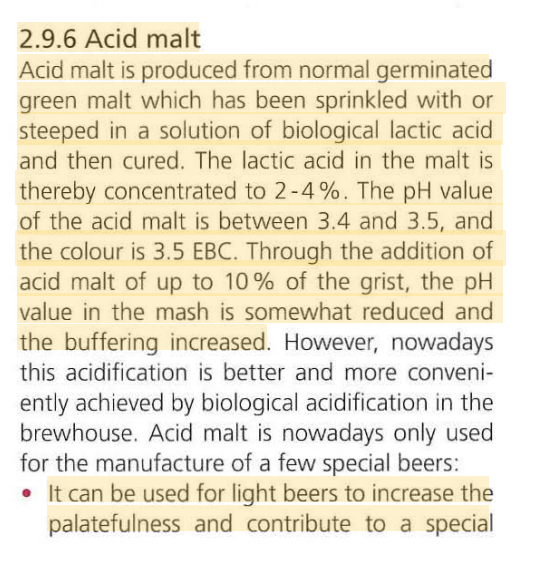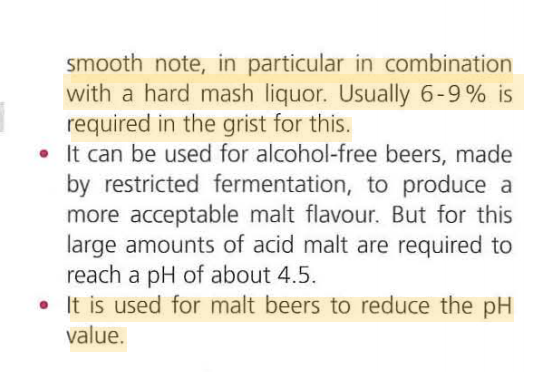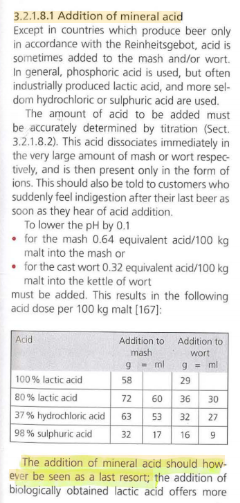- Joined
- Jan 1, 2016
- Messages
- 335
- Reaction score
- 129
How much do I need to use to replace the 3% saurmaltz for a Hefe? I'm using @ajdelange method in the primer for RO water.

How much do I need to use to replace the 3% saurmaltz for a Hefe? I'm using @ajdelange method in the primer for RO water.
Approx...
1 oz 3% Acid Malt = 8.8 ml 10% Phosphoric Acid = 0.8 ml 88% ml Lactic Acid
I don't have any, otherwise I would go with it. Just working with what I have on hand.Any reason why you’d want to not use the Sauermalz?
I don't have any, otherwise I would go with it. Just working with what I have on hand.
Acid malt has it's place, but it's not a full panacea for acidification. If your water source has relatively low alkalinity, then you can get by with acid malt. But if your water has significant alkalinity, you'll need to use some other form of acidification to neutralize your sparging water.
My problem with acid malt is its inconsistency in acidity. It's a natural product that can exhibit variation in acidity. If you're willing to monitor and assess your acid malt strength, you can produce decent mashing pH adjustment. But, I contend that most brewers would find that using a consistent and reliable acid source is better.
I used 10 ML of phosphoric and 1/4tsp of CaCl for my RO sytem water, now its measuring at 4.8 PH. Idk...
Weyermann Sauermalz is pretty darn consistent. Since I don’t sparge or use a kettle acid addition, it works well for me.
Weyemann sauermalz is probably consistent and high quality product. The problem is that 'sour malt' or 'acid malt' is inconsistent between maltsters. My LHBS labels it as 'Acid Malt - imported'. It's most often Bestmalz, but varies. They can never tell me where it's from (they're quite helpful and friendly, but genuinely can't work out which bag of malt it's from). I'll stick to lactic or phosphoric acid.
From a recipe point of view, saying, for example '2% acid malt' is worthless, unless the brand of acid malt is specified.
I would be surprised if any maltster is able to consistently produce acid malt that's within, say, 3% of its nominal acid content, i.e. for a 3% acid malt, between 2.91% and 3.09%. Fortunately(?) there's so much else going on in in the mash that's variable that the pH impact of the variation might get lost in the noise. Even "normal" malts can have fairly surprising pH variation from batch to batch. (I know, because I've measured them individually.)
There's some debate about how maltsters produce acid malt and comply with the Reinheitsgebot, and they're not telling (Weyermann, for example, gives a cleverly worded answer that's open to interpretation), but any of the potential methods don't (IMO) scream consistency. Currently, Weyermann lists the pH (presumably a distilled water mash pH) of their acidulated malt as 3.3 - 4.5. Yikes. I think they used to list 3.4 - 3.6.
https://www.weyermann.de/usa/gelbe_Seiten_usa.asp?snr=1&idkat=1297&umenue=yes&idmenue=269&sprache=10
They spray the malt with Sauergut. Weyermann is the only maltster putting out a highly consistent Sauermalz in my opinion.
Do you have a source for this information (other than internet lore, which also includes a couple other methods)? I have always believed Weyermann was spraying, but never had any first hand information.
If you look closely, the source is the source:
https://www.weyermann.de/usa/faq.asp?umenue=yes&idmenue=294&sprache=10
They say lactic acid but make it a point to say it’s naturally occurring on the grains. This is how you go about making a Sauergut batch/Ongoing supply. You take some uncrushed grains and some wort and Viola!
Add to that the fact that they manufacturer and sell Sauergut, and also have a small brewery on site, and to me it’s just short of being a no brainer.
I've read those words before, i.e. : "Weyermann® Acidulated Malt is produced by using lactic acid, which is generated by on grain natural occurring lactic bacteria."
I believe this almost certainly means they spray, but it can also be argued other ways. For example, I've seen people insist that the malt is moistened to encourage lactobacillus growth (like a quasi sour mash) and then halted, with the result being the malt that the acid was actually produced on becomes the acid malt. Personally, I think that's borderline preposterous. Where would the sugar come from? And yet, I see this and other variations out there.
Well, that throws a monkey wrench in my theory, doesn't it?
Still doesn't make sense to me any other way.

Hidden in plain sight.

Oh, of course. Spraying the malt with Sauergut, to me, is the most plausible explanation for how they produce the Sauermalz. I don’t think it matters that they source it from a 3rd party.
After all the talking we’ve done about that product, I’m surprised it slipped my mind that Weyermann wasn’t actually producing it in house.


We don't have to look very far, to know how Sauermalz is made


Is the 88% lactic acid which is available in the USA (or the 80% concentration that is available in many other countries) of biological or synthetic (chemical reaction process) origin?
Is the 88% lactic acid which is available in the USA (or the 80% concentration that is available in many other countries) of biological or synthetic (chemical reaction process) origin?

Is the 88% lactic acid which is available in the USA (or the 80% concentration that is available in many other countries) of biological or synthetic (chemical reaction process) origin?
Enter your email address to join: